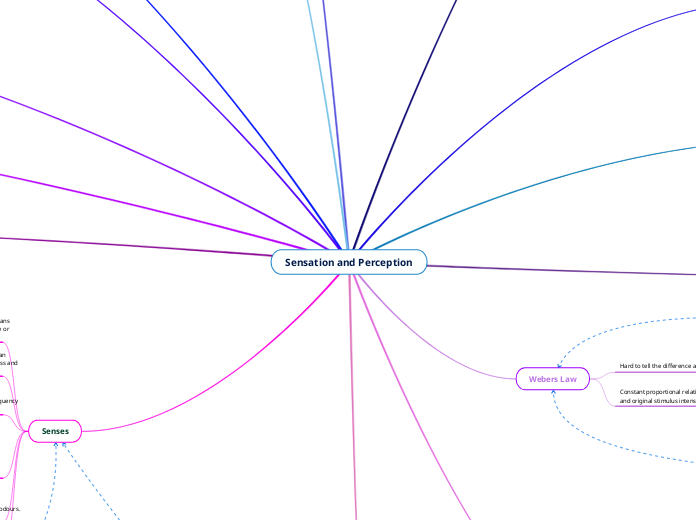Sensation and Perception
Sensation
The detection of physical energy by sense organs and perception
Perception
The brains interpretation of raw sensory input.
Psychophysics
The study of how we percieve sensory stimuli based on physical characteristics
Fun fact: Some dogs have 220 million or more olfactory receptors compared to 5 million for humans.
Cycle: Think, Pair, Share
Every experience you have, there's sensory input
processing and response. The brain gives
interpretive structure
Response is generated, sensory receptors are stimulated,
and sensory information is orgaized and interpreted,
stored and related to previous experiences.
Situation: If you see a car driving towards you, you move
out of the way. Take cycle, map it onto what you know
Webers Law
Hard to tell the difference at higher frequencies
Lower - Easier
Example: Car volume - 10-15 sounds
like a much bigger difference than 25-30
Constant proportional relationship between the JND
and original stimulus intensity
Absolute threshold
The second you hear, see or feel something it has
entered your absolute threshold.
Deifference threshold:
Tell the difference in what you
see, hear and feel.
The smallest level of stimulus that can be
detected usually defined as at least
half the time.
Sensory memory
Transduction: Process of conveting an external energy
or substance into a neural activity
Everything in our memory begins as sensory input
from our environment.
99% of all sensory information is discarded almost
imediately upon entering the brain
People do not perceive a lot of what they see
Role: Take the information coming into the brain
through sensory receptors and hold it until
a decision is made about what to do with it.
Parallel processing
How we can attend to many sense modalities
simultaneously
Our minds build up perception by piecing together
what is in the sensory field and what was there a moment ago
as well as what we remember from our past
Subliminal persuasion
Argues that we can be made to behave or act in
a particular way as a result of a mesage presented
at the subliminal level
Does NOT drive attention
Opponent process
We perceive colour as either red or green or as
either blue or yellow
Accomodation process
Changes the lenses shape to focus light onto the back
of the eyes allowing us to adapt to different
light conditions
Signal detection theory
Developed to help psychologists determine
how we detect stimuli under uncertain conditions
Illusion
The process involving an interaction of logical and empirical considerations
After effects of the stimulation or overstimulation
of the senses
When any of the sense organs "transmit misleading information of the brain"
Illusions use the way our brains work to perceive
the world around us
4 types of illusion: 1. ambiguous illusions 2. distorting/geometrical optical illusions 3. paradox illusions or fictions
Senses
Any of the faculties by which humans
or animals take in info from inside or
outside the body
Sight - Humans derive more info from sight than
any other senses. The eyes take in light, process and
transmits.
Hearing - Sound has two main components (Frequency
and amplitude)
Frequency: Describes pitch (low
or high) measured in hertz.
Amplitude: Describes volume measured in decibels.
Touch - Skin has 3 distinct layers. 1. Epidermis, 2. Dermis, 4. Hypodermis. Skin is resiliant and waterproof. Also, the largest organ in the human body.
Epidermis : Outer layer, regenerates every
28 days
Dermis : Contains line cells, nerve endings
Hypodermis : Deeper layer, thick, insulating cushion
Taste and smell - Olfactory bulbs in the nose sense odours.
Taste buds found on tongue.
Smell and memory - Highly associated. Process
of smell near hippocampus.
Attention
Selective attention: Purposeful focusing
of conscious awareness on a specific stimulus or
event in the environment to the relative exclusion
of other stimuli and events.
What you are perceiving right now depends
greatly on where your attention is
Multi tasking v.s task shifting
Automatized experiences: Used to doing something so you
repeat it.
What drives attention: External force, novelty and
familiarity (meaning, ditchotomic), emotional (personal)
